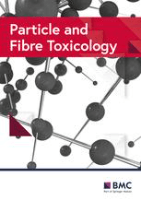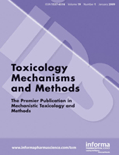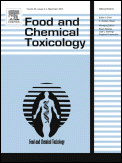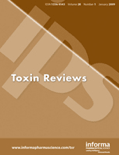
Particle and Fibre Toxicology
Scope & Guideline
Illuminating the effects of environmental agents.
Introduction
Aims and Scopes
- Toxicological Assessments of Particulate Matter:
The journal frequently publishes research examining the toxicological effects of various particulate matter, including nanoparticles and fibers, on biological systems, emphasizing methodologies such as in vivo and in vitro studies. - Mechanistic Insights into Particle-Induced Toxicity:
Research articles often delve into the cellular and molecular mechanisms through which particulate matter induces toxicity, inflammation, and other adverse health effects, contributing to a deeper understanding of these processes. - Multidisciplinary Approaches to Nanotoxicology:
The journal encourages studies that utilize multidisciplinary approaches, integrating toxicology, pharmacokinetics, and epidemiology to assess risks associated with exposure to engineered nanomaterials and environmental pollutants. - Impact of Environmental and Dietary Factors on Toxicity:
There is a consistent focus on how environmental pollutants, including diesel exhaust and microplastics, interact with dietary factors to influence health outcomes, particularly in vulnerable populations. - Innovative Methodologies for Risk Assessment:
The journal highlights innovative methodologies for risk assessment, including high-throughput screening and omics technologies, to evaluate the health effects of emerging particulate contaminants.
Trending and Emerging
- Microplastics and Their Health Impacts:
Research on the health effects of microplastics has surged, reflecting growing public and scientific concern over their ubiquitous presence in the environment and potential toxicity. - Nanomaterials and Targeted Toxicity Mechanisms:
A significant increase in studies focusing on the specific mechanisms of toxicity associated with various nanomaterials, including their interactions at the cellular level, has been noted, indicating a deeper exploration of their health risks. - Impact of Environmental Pollutants on Chronic Diseases:
Emerging themes are focusing on the links between exposure to environmental pollutants, such as diesel exhaust, and chronic diseases, including cardiovascular conditions and metabolic disorders, emphasizing the long-term health implications. - Sex Differences in Toxicological Responses:
There is a growing interest in understanding the role of sex differences in the toxicological responses to particulate matter, as evidenced by studies examining how hormonal variations affect susceptibility to toxicity. - Integrated Risk Assessment Frameworks:
The development and application of integrated risk assessment frameworks that combine data from various sources, including epidemiological studies and mechanistic insights, are becoming increasingly prominent, signaling a shift towards holistic approaches in toxicology.
Declining or Waning
- Traditional Toxicology Studies Without Modern Techniques:
There is a noticeable decrease in the publication of studies relying solely on traditional toxicology methods without integrating modern techniques such as omics approaches or advanced imaging, indicating a shift towards more innovative methodologies. - Limited Focus on Non-Respiratory Health Effects:
Research specifically targeting non-respiratory health impacts of particulate matter exposure, such as gastrointestinal or skin effects, has become less frequent, suggesting a narrowing of focus towards pulmonary and systemic effects. - Studies Concentrating Solely on In Vitro Models:
The publication of studies that exclusively utilize in vitro models without corroborating in vivo findings has diminished, reflecting a preference for comprehensive studies that bridge laboratory results with real-world implications.
Similar Journals

REPRODUCTIVE TOXICOLOGY
Delivering high-impact insights into toxicology and reproduction.REPRODUCTIVE TOXICOLOGY, published by Pergamon-Elsevier Science Ltd, stands as a pivotal journal in the field of toxicology, specifically focusing on the effects of environmental and pharmaceutical agents on reproductive health. Established in 1987, the journal has a rich history of contributing to the scientific community, and it continues to publish rigorous research and reviews that illuminate the intricate relationships between various toxicants and their reproductive impacts. With an impressive 2023 Q2 ranking in Toxicology and a Scopus ranking of #42 out of 133 in the Toxicology category, REPRODUCTIVE TOXICOLOGY emphasizes high-quality scholarly work that influences both academia and industry practices. Researchers, professionals, and students in toxicology, pharmacology, and public health will find this journal an invaluable resource for staying informed on the latest findings and methodologies in reproductive toxicology. While the journal currently adheres to traditional publishing models without open access options, its authoritative content remains accessible to a global audience interested in advancing the understanding of toxicological impacts on reproduction.

CHEMICAL RESEARCH IN TOXICOLOGY
Unveiling the complexities of chemical toxicity for a safer future.Chemical Research in Toxicology is a premier journal published by the American Chemical Society, dedicated to advancing the understanding of toxicological effects associated with chemical substances. Since its inception in 1988, this esteemed journal has maintained a robust impact factor, ranking in the Q1 quartile for both Medicine (miscellaneous) and Toxicology as of 2023, reflecting its significance and influence in the fields of pharmacology and toxicology. With an impressive Scopus ranking at #16 out of 133 in the Toxicology category, it serves as a vital resource for researchers, professionals, and students seeking cutting-edge insights and scholarly articles that bridge the gap between chemistry and toxicological science. Although not an open-access publication, it continues to provide comprehensive analyses and original research that inform safe chemical practices and regulatory policies, further enhancing its role in public health and safety.

Food Additives and Contaminants Part A-Chemistry Analysis Control Exposure & Risk Assessment
Advancing food safety through rigorous analysis and risk assessment.Food Additives and Contaminants Part A-Chemistry Analysis Control Exposure & Risk Assessment, published by Taylor & Francis Ltd, is a leading journal in the field of food science, toxicology, and public health. With an ISSN of 1944-0049 and an E-ISSN of 1944-0057, this esteemed publication has established itself as a vital resource for researchers and professionals involved in the analysis and regulation of food additives and contaminants. Since its inception and through its converged years from 2008 to 2012 and again from 2014 to 2023, the journal has maintained an impactful presence, notably achieving a Q2 ranking in diverse categories including Chemistry (miscellaneous) and Food Science, alongside commendable standings in Health and Environmental Health. The journal’s mission is to foster high-quality research by providing a platform for critical studies related to chemical analysis, exposure assessments, and risk management in food safety. By prioritizing engaging, peer-reviewed content, it aims to enhance understanding and mitigate risks associated with food additives, making it an indispensable tool for academics, practitioners, and policymakers alike.

BULLETIN OF ENVIRONMENTAL CONTAMINATION AND TOXICOLOGY
Connecting science and policy for a sustainable future.BULLETIN OF ENVIRONMENTAL CONTAMINATION AND TOXICOLOGY, published by SPRINGER, is a pivotal journal in the fields of Environmental Science, Toxicology, and Public Health. With a strong history of dissemination since its inception in 1966, the journal predominantly focuses on the latest advances in understanding environmental contaminants and their toxicological effects on health and ecosystems. It currently holds a respectable Q2 ranking across multiple categories including Health, Toxicology and Mutagenesis, Medicine (miscellaneous), and Pollution, as per the 2023 metrics. While the journal is not Open Access, it provides an invaluable platform for researchers, professionals, and students seeking to contribute to and stay informed on critical issues regarding environmental hazards and their implications. With an engaged community of scholars and practitioners, this journal continues to be an essential resource for addressing the pressing challenges of environmental contamination and its health impacts, guiding future research and policy decisions.

TOXICOLOGY LETTERS
Unveiling the impacts of substances on health and environment.TOXICOLOGY LETTERS is a prominent journal dedicated to advancing the field of toxicology, providing a platform for high-quality research and reviews that explore the effects of chemical substances on biological systems. Published by Elsevier Ireland Ltd, this peer-reviewed journal has established itself as a vital resource in toxicological research since its inception in 1977, with a convergence of studies extending to 2024. With an impressive Scopus ranking, positioned at #28 out of 133 in the Toxicology category, TOXICOLOGY LETTERS garners a respectable percentile of 79, highlighting its significance in the academic community. Although it is not an open-access journal, its research is accessible through institutional subscriptions, ensuring that critical insights into human health and environmental safety are disseminated effectively. Being categorized in the Q2 quartile in both Medicine (miscellaneous) and Toxicology for 2023 further emphasizes its relevance and impact in these fields. This journal aims to foster collaboration between researchers and professionals, encouraging the exploration of innovative solutions to chemical hazards and the promotion of safer practices in pharmacology and toxicology.

TOXICOLOGY MECHANISMS AND METHODS
Leading the charge in toxicology advancements globally.TOXICOLOGY MECHANISMS AND METHODS is a distinguished peer-reviewed journal dedicated to the advancement of toxicological research, published by Taylor & Francis Ltd. With its ISSN 1537-6516 and E-ISSN 1537-6524, this esteemed journal features critical studies and innovative methodologies in the field of toxicology, aligning with its mission to enhance understanding of biological mechanisms and risk assessment. The journal holds a commendable Q2 ranking in both the Health, Toxicology and Mutagenesis, and Toxicology categories, as well as strong positions in Scopus rankings, reflecting its influence with a 71st percentile rank in Toxicology and a 69th percentile rank in Environmental Health. Researchers, professionals, and students in the toxicology domain will find this journal to be an invaluable resource, offering open access options that foster widespread dissemination of its findings. Since its inception, encompassing converged years from 1991 to 1995 and from 2002 to 2024, the journal remains at the forefront of critical discourse and innovative research methods, making it a vital platform for advancing toxicological science globally.

Current Research in Toxicology
Exploring the Frontiers of Toxicology ScienceCurrent Research in Toxicology is a pioneering journal published by ELSEVIER that serves as a vital platform for disseminating cutting-edge research in the field of toxicology, spanning from biological impacts to pharmacological applications. With an ISSN of 2666-027X and an impressive Q2 ranking in key categories such as Applied Microbiology and Biotechnology, Health, Toxicology and Mutagenesis, and Toxicology, this journal underscores its commitment to high-quality research and significant contributions to the scientific community. Based in the Netherlands, Current Research in Toxicology aims to bridge the gap between academia and industry by providing rigorously peer-reviewed articles that cover a wide array of topics including novel methodologies, regulatory challenges, and emerging trends within the domain. The journal is accessible through various platforms, making it essential for researchers, professionals, and students eager to stay updated on the latest findings and advancements in toxicology. With a comprehensive focus on integrating theory with practical application, this journal is poised to influence future studies and policies in health and environmental science.

JOURNAL OF TOXICOLOGY AND ENVIRONMENTAL HEALTH-PART A-CURRENT ISSUES
Pioneering Insights into Human Health and Environmental AgentsJOURNAL OF TOXICOLOGY AND ENVIRONMENTAL HEALTH-PART A-CURRENT ISSUES, published by Taylor & Francis Inc, stands as a key resource in the interdisciplinary field of toxicology and environmental health. Operating under the ISSN 1528-7394 and E-ISSN 1087-2620, this journal maintains a strong presence with a Q2 category ranking in Health, Toxicology and Mutagenesis and a Q3 ranking in Toxicology as of 2023. It aims to disseminate critical findings that address contemporary issues in toxicology and environmental health, emphasizing the implications of environmental agents on human health. The journal offers both subscription and open access options, making cutting-edge research accessible to a diverse readership. With coverage of key topics from 1998 to 2024, it is an essential platform for academics, professionals, and students seeking to stay at the forefront of environmental health sciences.

FOOD AND CHEMICAL TOXICOLOGY
Transforming toxicology knowledge into actionable insights.FOOD AND CHEMICAL TOXICOLOGY, published by Pergamon-Elsevier Science Ltd, is a prestigious journal with a significant impact in the fields of food science, medicine, and toxicology, reflecting its Q1 and Q2 quartile rankings in various categories as of 2023. Established in 1982, this journal continues to serve as an essential platform for disseminating high-quality research focused on the toxicological assessment of foods and chemicals, aiming to advance knowledge that affects public health and safety. With a pivotal role in integrating diverse disciplines, including pharmacology and agricultural sciences, the journal ranks impressively within the top percentiles—specifically 95th in Toxicology and 92nd in Food Science on the Scopus metrics. Though it operates on a traditional subscription model, the journal is committed to providing valuable insights and findings to researchers, professionals, and students across the globe, making it a vital resource in the ongoing discourse around food safety and environmental health. Its comprehensive scope underscores its importance in shaping evidence-based policies and practices.

Toxin Reviews
Advancing the Science of ToxicologyToxin Reviews is a premier academic journal focused on the critical field of Toxicology, published by Taylor & Francis Inc. Established with an aim to foster research and disseminate knowledge, this journal has been pivotal since its inception in 1982 and continues to be a leading platform for both emerging and established researchers. With an impressive impact factor and ranked in the 75th percentile among its peers in the Scopus categories, it serves as an essential resource for scientists, practitioners, and students interested in understanding the complexities of toxins and their effects on health. The journal provides an Open Access platform, enhancing visibility and accessibility of research findings to a broader audience. Covering a wide scope, Toxin Reviews plays a vital role in bridging gaps between toxicological research and practical applications, ensuring that rigorous scientific inquiry translates into real-world solutions.